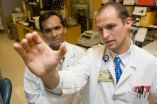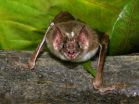Click here for more information.
August 3, 2011 — (Bronx, NY) — People who live to 95 or older are no more virtuous than the rest of us in terms of their diet, exercise routine or smoking and drinking habits, according to researchers at Albert Einstein College of Medicine of Yeshiva University. Their findings, published today in the online edition of Journal of the American Geriatrics Society, suggests that "nature" (in the form of protective longevity genes) may be more important than "nurture" (lifestyle behaviors) when it comes to living an exceptionally long life. Nir Barzilai, M.D., the Ingeborg and Ira Leon Rennert Chair of Aging Research and director of the Institute for Aging Research at Einstein, was the senior author of the study.
Dr. Barzilai and his Einstein colleagues interviewed 477 Ashkenazi Jews who were living independently and were 95 and older (95-112, 75 percent of them women). They were enrolled in Einstein's Longevity Genes Project, an ongoing study that seeks to understand why centenarians live as long as they do. (Descended from a small founder group, Ashkenazi Jews are more genetically uniform than other populations, making it easier to spot gene differences that are present.) The elderly participants were asked about their lifestyles at age 70, considered representative of the lifestyle they'd followed for most of their adult lives. They answered questions about their weight and height so that their body mass index (BMI) could be calculated. They also provided information about their alcohol consumption, smoking habits, physical activity, and whether they ate a low-calorie, low-fat or low-salt diet. To compare these long-lived individuals with the general population, the researchers used data from 3,164 people who had been born around the same time as the centenarians and were examined between 1971 and 1975 while participating in the National Health and Nutrition Examination Survey (NHANES I). Overall, people with exceptional longevity did not have healthier habits than the comparison group in terms of BMI, smoking, physical activity, or diet. For example, 27 percent of the elderly women and an equal percentage of women in the general population attempted to eat a low-calorie diet. Among long-living men, 24 percent consumed alcohol daily, compared with 22 percent of the general population. And only 43 percent of male centenarians reported engaging in regular exercise of moderate intensity, compared with 57 percent of men in the comparison group.
"In previous studies of our centenarians, we've identified gene variants that exert particular physiology effects, such as causing significantly elevated levels of HDL or 'good' cholesterol," said Dr. Barzilai, who is also professor of medicine and of genetics at Einstein. "This study suggests that centenarians may possess additional longevity genes that help to buffer them against the harmful effects of an unhealthy lifestyle."
The research did find, however, that overweight centenarians tended to have lower rates of obesity than the control group. Although male and female centenarians were just as likely to be overweight as their counterparts in the general population, the centenarians were significantly less likely to become obese: only 4.5 percent of male centenarians were obese vs. 12.1 percent of controls; and for women, 9.6 percent of centenarians were obese versus 16.2 percent of controls. Both of these differences are statistically significant.
While longevity genes may protect centenarians from bad habits, healthy lifestyle choices remain critical for the vast majority of the population. The U.S. Census Bureau estimates there were nearly 425,000 people aged 95 and older living in the U.S. in 2010 − a fraction (.01) of the 40 million U.S. adults 65 and over.
"Although this study demonstrates that centenarians can be obese, smoke and avoid exercise, those lifestyle habits are not good choices for most of us who do not have a family history of longevity," said Dr. Barzilai. "We should watch our weight, avoid smoking and be sure to exercise, since these activities have been shown to have great health benefits for the general population, including a longer lifespan." Researchers also asked study participants why they believed they had lived so long. Most did not attribute their advanced age to lifestyle factors. One-third reported a history of family longevity, while 20 percent believed that physical activity also played a role in their lifespan. Other factors included positive attitude (19 percent), busy or active life (12 percent), less smoking and drinking (15 percent), good luck (8 percent), and religion or spirituality (6 percent). ### The paper is titled "Lifestyle Factors of People with Exceptional Longevity." Other Einstein authors were Yingheng Liu, Ph.D., Orit Ben-David, Saritha Reddy, M.B.B.S., Gil Atzmon, Ph.D., and Jill Crandall, M.D., Swapnil N. Rajpathak, M.B.B.S., Dr.PH., now at Merck Pharmaceuticals, was the study's lead author. The research was supported by grants from the National Institute on Aging of the National Institutes of Health.
About Albert Einstein College of Medicine of Yeshiva University
Albert Einstein College of Medicine of Yeshiva University is one of the nation's premier centers for research, medical education and clinical investigation. During the 2009-2010 academic year, Einstein is home to 722 M.D. students, 243 Ph.D. students, 128 students in the combined M.D./Ph.D. program, and approximately 350 postdoctoral research fellows. The College of Medicine has 2,775 fulltime faculty members located on the main campus and at its clinical affiliates. In 2009, Einstein received more than $155 million in support from the NIH. This includes the funding of major research centers at Einstein in diabetes, cancer, liver disease, and AIDS. Other areas where the College of Medicine is concentrating its efforts include developmental brain research, neuroscience, cardiac disease, and initiatives to reduce and eliminate ethnic and racial health disparities. Through its extensive affiliation network involving five medical centers in the Bronx, Manhattan and Long Island - which includes Montefiore Medical Center, The University Hospital and Academic Medical Center for Einstein - the College of Medicine runs one of the largest post-graduate medical training programs in the United States, offering approximately 150 residency programs to more than 2,500 physicians in training. For more information, please visit www.einstein.yu.edu



